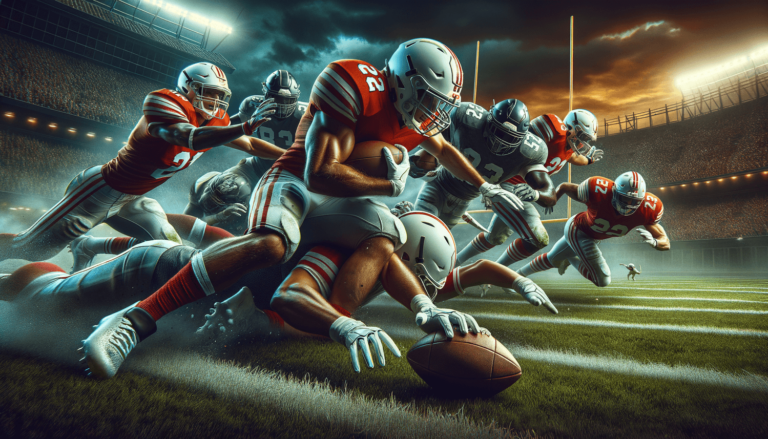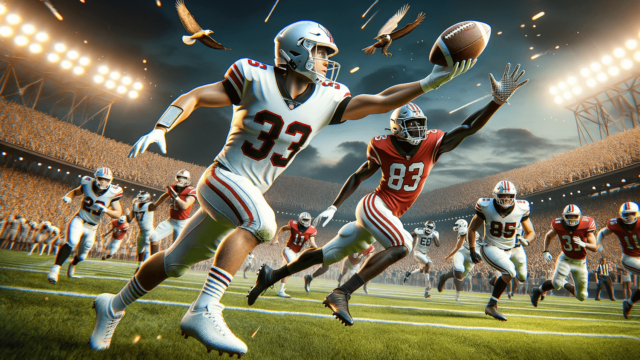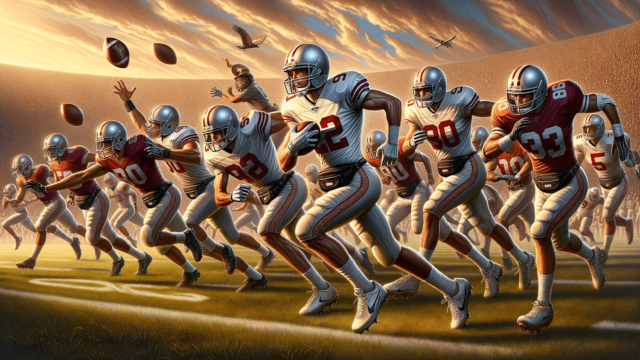
A fumble in football occurs when a player has possession of the ball but subsequently loses control, resulting in the ball being available for recovery by either team. Usually caused by a hit from an opposing player, slips, or poor handling, fumbles can lead to turnovers and drastically change the course of a game.
Understanding Fumbles in Football
A fumble is a crucial event in football that can significantly impact the outcome of a game. It occurs when a player with possession of the ball loses control, making the ball available for recovery by either team. Fumbles can be caused by hits from opposing players, slips, or poor handling of the ball.
Causes of Fumbles
1. Contact from Opponents
One of the primary causes of fumbles is contact from the opposing team. Hard hits or well-executed tackles can knock the ball loose and potentially lead to a turnover. It’s essential for ball carriers to protect the ball securely and anticipate potential threats from defenders.
2. Slips and Missteps
Slips and missteps can also lead to fumbles, especially in challenging weather conditions. Wet or icy fields can make it difficult for players to maintain balance, increasing the likelihood of a fumble as the ball carrier tries to avoid a tackle.
3. Poor Ball Handling
Proper ball handling is crucial to avoiding fumbles. When players mishandle the ball due to poor grip or incorrect hand positioning, they increase their chances of fumbling. Regular practice and focus on proper technique can reduce the likelihood of poor ball handling leading to fumbles.
Recovering a Fumble
When a fumble occurs, the ball is in play and available for either team to recover. The team that recovers the fumble gains possession and can continue their offensive drive or, in the case of the defense, potentially score on a fumble return. Players must dive on the ball or scoop it up securely to ensure a successful recovery.
Preventing Fumbles
Teams can minimize the risk of fumbles by emphasizing proper ball security techniques, such as keeping the ball tucked tightly under the arm and using the off-arm to prevent defenders from stripping the ball. Additionally, maintaining grip strength and familiarity with various weather conditions can help reduce the occurrence of fumbles.
Types of Fumbles
There are different kinds of fumbles that can occur during a football game, each with varying impacts on the outcome:
1. Forced Fumble
A forced fumble occurs when a defender intentionally targets the ball to dislodge it from the ball carrier’s grip. This is a strategic maneuver aimed at creating an opportunity for the defense to recover the ball and gain possession.
2. Unforced Fumble
An unforced fumble is when the ball carrier loses possession without direct contact from a defender. Unforced fumbles may be caused by poor handoffs, mishandling snaps, or losing balance on the field.
Impact of Fumbles on the Game
When a fumble occurs, the flow of the game can quickly change, leading to newfound momentum for the team that recovers the loose ball. Teams with a high rate of fumbles are more likely to lose games due to a potential increase in the number of offensive possessions for opponents or even defensive scores against them.
Notable Fumbles in Football History
Certain fumbles throughout football history have had a significant impact on the game and left lasting impressions on fans:
1. The Miracle at the Meadowlands
In 1978, the New York Giants were leading the Philadelphia Eagles with less than a minute left in the game. Rather than kneeling to run out the clock, the Giants attempted a handoff, which resulted in a fumble. The Eagles’ Herm Edwards picked up the loose ball and scored a touchdown, winning the game for Philadelphia.
2. The Immaculate Reception
During the 1972 AFC Divisional Round, Pittsburgh Steelers’ Franco Harris picked up a loose ball after it ricocheted off two players during a last-second desperate pass. Harris ran the ball into the end zone to win the game, creating one of the most memorable plays in football history.
3. Ernest Byner’s ‘The Fumble’
In the 1987 AFC Championship, Cleveland Browns’ Ernest Byner appeared en route to a game-tying touchdown until he fumbled the ball at the 1-yard line. The Denver Broncos recovered the ball, ultimately winning the game and denying the Browns a Super Bowl appearance.
FAQ Section
After learning about fumbles in football, readers may have additional questions. This frequently asked questions section addresses the most common inquiries to further help understand the concept of fumbling in football.
What is the difference between a fumble and an interception?
A fumble refers to when a player with possession of the ball loses control of it. In contrast, an interception occurs when a defender catches a forward pass from the offense’s quarterback without the ball touching the ground. While both events can lead to turnovers, they differ in the manner and context in which they occur.
Can a fumble result in an offensive score?
Yes, a fumble can result in an offensive score. This can happen if the player who initially fumbles the ball or another offensive player recovers the loose ball and subsequently advances it into the opponent’s end zone, scoring a touchdown.
Can the offense advance a fumble forward on fourth down?
According to football rules, only the player who initially fumbled the ball is allowed to advance it forward during a fourth-down play. If another offensive player recovers the fumble, the ball is dead at the recovery spot, and the other team takes possession at that point.
Does a fumble count as a negative statistic for the player who fumbled?
Yes, a fumble is typically considered a negative statistic for the player who lost control of the ball. This is because fumbles are a liability, increasing the risk of turnovers that can harm a team’s overall performance and success during a game.
How are fumbles recorded in football statistics?
Fumbles are recorded in football statistics using a variety of metrics. The primary metrics are fumbles (total number of times a player loses control of the ball) and fumbles lost (number of times the opposing team recovers the player’s fumble). Moreover, for defenders, forced fumbles (number of times they dislodge the ball from the opponent) are also recorded as a positive defensive statistic.
Featured Posts
- No pillar pages found.





